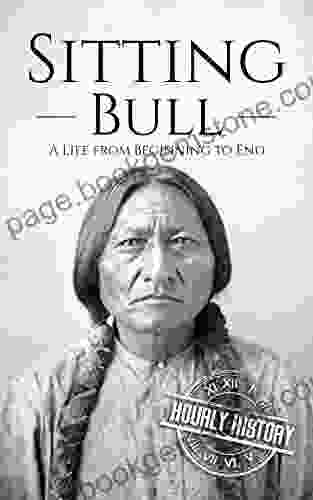Life From Beginning To End: A Comprehensive Guide to Native American History

Native American history is a vast and complex subject, spanning thousands of years and encompassing a wide range of cultures and experiences. In this article, we will provide a comprehensive overview of Native American history, from its origins to the present day. We will cover key events, figures, and themes, and we will illustrate our discussion with numerous historical images.
4.3 out of 5
| Language | : | English |
| File size | : | 970 KB |
| Text-to-Speech | : | Enabled |
| Enhanced typesetting | : | Enabled |
| Word Wise | : | Enabled |
| Print length | : | 45 pages |
| Lending | : | Enabled |
| Screen Reader | : | Supported |
Origins
The first humans arrived in North America from Asia across the Bering Land Bridge around 13,000 years ago. These early migrants were nomadic hunters and gatherers who gradually spread across the continent, adapting to the different environments they encountered. Over time, they developed distinct cultures and languages.
Pre-Columbian Era
By the time Europeans arrived in the Americas in the 15th century, there were an estimated 10 million Native Americans living in North America. These Native Americans belonged to hundreds of different tribes, each with its own unique culture, language, and traditions. Some of the most well-known tribes include the Apache, Cherokee, Iroquois, Navajo, and Sioux.
Native Americans had a profound impact on the environment of North America. They cleared forests to create farmland, built irrigation systems to water their crops, and hunted and fished to provide food for their families. They also developed complex political and social systems, and they created beautiful works of art, music, and literature.
European Contact
The arrival of Europeans in the Americas had a devastating impact on Native Americans. Europeans brought with them diseases, which killed millions of Native Americans. They also brought with them a desire for land and resources, which led to conflicts with Native Americans.
In the 16th century, Spain established a number of colonies in North America. These colonies were based on the forced labor of Native Americans, who were enslaved and worked to death in mines and on plantations.
In the 17th and 18th centuries, England and France also established colonies in North America. These colonies were based on the fur trade, and Native Americans were forced to trap and sell furs to European traders.
American Revolution
Native Americans played a significant role in the American Revolution. Many Native American tribes allied with the British, while others allied with the Americans. The Iroquois Confederacy, for example, remained neutral throughout the war.
After the American Revolution, the new United States government began to expand westward. This expansion led to conflicts with Native Americans, who were forced to give up their land and move to reservations.
Indian Removal Act
In 1830, the United States Congress passed the Indian Removal Act. This act authorized the federal government to forcibly remove Native Americans from their land in the East and relocate them to reservations in the West. The Indian Removal Act was a disaster for Native Americans. Thousands of Native Americans died on the Trail of Tears, the forced march from their homes in the East to reservations in the West.
Indian Wars
The Indian Removal Act led to a series of wars between Native Americans and the United States government. These wars lasted for decades and resulted in the deaths of thousands of Native Americans.
Some of the most famous Indian Wars include the Apache Wars, the Black Hawk War, the Cheyenne War, the Comanche War, the Nez Perce War, and the Sioux War.
Reservation Era
After the Indian Wars, Native Americans were forced to live on reservations. Reservations are areas of land that are set aside for Native Americans by the federal government. Native Americans are not allowed to leave reservations without permission from the government.
Life on reservations was difficult for Native Americans. They were often poor and had little access to education, healthcare, and other basic services. They were also subject to discrimination and violence from non-Native Americans.
Termination Era
In the 1950s and 1960s, the United States government pursued a policy of termination. This policy aimed to end the federal government's relationship with Native American tribes and to assimilate Native Americans into American society.
Termination was a disaster for Native Americans. It led to the loss of tribal land, culture, and identity.
Indian Civil Rights Movement
In the 1960s, Native Americans began to fight for their civil rights. They organized protests, marches, and other actions to demand an end to discrimination and to improve their living conditions.
The Indian Civil Rights Movement was successful in achieving a number of important goals. In 1968, Congress passed the Indian Civil Rights Act, which prohibited discrimination against Native Americans in employment, housing, and other areas. In 1975, Congress passed the Indian Self-Determination and Education Assistance Act, which gave Native American tribes more control over their own affairs.
Native American Today
Today, there are over 570 federally recognized Native American tribes in the United States. These tribes have a combined population of over 5.2 million people. Native Americans live in all 50 states, but they are most concentrated in the West.
Native Americans face a number of challenges today, including poverty, unemployment, and discrimination. However, they are also working to preserve their cultures and traditions and to improve their quality of life.
Native American history is a complex and often tragic story. However, it is also a story of resilience and hope. Native Americans have survived centuries of oppression and discrimination.
4.3 out of 5
| Language | : | English |
| File size | : | 970 KB |
| Text-to-Speech | : | Enabled |
| Enhanced typesetting | : | Enabled |
| Word Wise | : | Enabled |
| Print length | : | 45 pages |
| Lending | : | Enabled |
| Screen Reader | : | Supported |
Do you want to contribute by writing guest posts on this blog?
Please contact us and send us a resume of previous articles that you have written.
 Best Book
Best Book Page Flip
Page Flip Bookshelf
Bookshelf Literary loom
Literary loom Chapter
Chapter Bookish
Bookish PageTurner
PageTurner Bibliophile
Bibliophile Story
Story Inkwell
Inkwell Bookworm
Bookworm Labyrinth
Labyrinth Plot Twist
Plot Twist Prose
Prose Paperback
Paperback Storyteller
Storyteller Sanctuary
Sanctuary Fiction
Fiction Reading
Reading Chronicle
Chronicle Read
Read Tanav Patkar
Tanav Patkar Reid Mitenbuler
Reid Mitenbuler Kaitlyn Dornbier
Kaitlyn Dornbier Jonathan Drori
Jonathan Drori Mary Antin
Mary Antin Thefirstdefier
Thefirstdefier Katherine Arden
Katherine Arden Kiyoshi Takahashi
Kiyoshi Takahashi Steven Konkoly
Steven Konkoly Jennifer L Scott
Jennifer L Scott Julia Zarankin
Julia Zarankin Tyanna
Tyanna Phillip Barlag
Phillip Barlag Philip Gwynne Jones
Philip Gwynne Jones Maureen T Corrigan
Maureen T Corrigan Linda Langner
Linda Langner Zack Meisel
Zack Meisel Joan Mellen
Joan Mellen Viet Thanh Nguyen
Viet Thanh Nguyen Fran Macilvey
Fran Macilvey Sam Pivnik
Sam Pivnik Keith Fenwick
Keith Fenwick Jeffrey B Perry
Jeffrey B Perry Hattie Gossett
Hattie Gossett Lali Duperti
Lali Duperti Jim Forest
Jim Forest Judy Friesem
Judy Friesem Joyce Yee
Joyce Yee Nicholas Sammond
Nicholas Sammond Bruce Hanington
Bruce Hanington Jean Paul Labourdette
Jean Paul Labourdette Paula M Block
Paula M Block Jose Vadi
Jose Vadi James Patterson
James Patterson Iain Rob Wright
Iain Rob Wright Travis Jeppesen
Travis Jeppesen Kenneth French
Kenneth French John Tateishi
John Tateishi Jasper T Scott
Jasper T Scott Slim Randles
Slim Randles Jay Brian Schoonmaker
Jay Brian Schoonmaker Karpov Kinrade
Karpov Kinrade Johno Ellison
Johno Ellison Jack C Ramsay
Jack C Ramsay Susan Zwerman
Susan Zwerman Kaoru Nonomura
Kaoru Nonomura David Railton
David Railton Kay Doherty Bennett
Kay Doherty Bennett Victoria Lewis
Victoria Lewis Melanie Clarke
Melanie Clarke Veronica Li
Veronica Li Alec Potrero
Alec Potrero Patrick Dimarchi
Patrick Dimarchi Louis L Amour
Louis L Amour Mariam V Lawal
Mariam V Lawal Martina M Lanier
Martina M Lanier E M Hardy
E M Hardy James Swallow
James Swallow Marion Zimmer Bradley
Marion Zimmer Bradley James Joseph
James Joseph Robert Rosen
Robert Rosen Maria Adolfsson
Maria Adolfsson Jessica Gadziala
Jessica Gadziala Steph The Hammer Hammerman
Steph The Hammer Hammerman Shawn Levy
Shawn Levy Jack Hitt
Jack Hitt K C Mills
K C Mills Joshua T Calvert
Joshua T Calvert Jan Cohen Cruz
Jan Cohen Cruz Hiroko Yoda
Hiroko Yoda Ben Shahn
Ben Shahn Theodore Menten
Theodore Menten Howard W French
Howard W French Deborah Frisch
Deborah Frisch Nancy Mitford
Nancy Mitford Jim Hutchinson
Jim Hutchinson Misty Copeland
Misty Copeland Interweave Editors
Interweave Editors Jelani Cobb
Jelani Cobb Parnaz Foroutan
Parnaz Foroutan Ronald Bergan
Ronald Bergan Suhas Mantri
Suhas Mantri Stephen L Carter
Stephen L Carter Jeanine Cornillot
Jeanine Cornillot Michael Head
Michael Head Ishmael Beah
Ishmael Beah Kandra Churchwell
Kandra Churchwell Shirish Deshpande
Shirish Deshpande Kira Salak
Kira Salak Susan Nagel
Susan Nagel Darby Penney
Darby Penney Sonya Lajuan
Sonya Lajuan Ryan Leslie
Ryan Leslie Samantha Irby
Samantha Irby Laylah Roberts
Laylah Roberts Edoardo Albert
Edoardo Albert James J Downes
James J Downes Melissa Maerz
Melissa Maerz Lawrence Durrell
Lawrence Durrell Tasha Black
Tasha Black Jesmyn Ward
Jesmyn Ward Tim Testu
Tim Testu Julia Rothman
Julia Rothman June Mcleod
June Mcleod Bianca Del Rio
Bianca Del Rio John R Kemp
John R Kemp Konchog Lhadrepa
Konchog Lhadrepa Slim Dusty
Slim Dusty R G Richardson
R G Richardson Ryan Dunlavey
Ryan Dunlavey Jeff Rovin
Jeff Rovin Rolf Giesen
Rolf Giesen Kathryn Warner
Kathryn Warner Jodi Ellen Malpas
Jodi Ellen Malpas Jessica Shorstein
Jessica Shorstein Philip Gourevitch
Philip Gourevitch J R Ward
J R Ward Jane Goodall
Jane Goodall Lally Brown
Lally Brown James Lawson
James Lawson Marty Sklar
Marty Sklar Tom Swimm
Tom Swimm Patti Mollica
Patti Mollica J A Hinds
J A Hinds Helena Reckitt
Helena Reckitt Roy John
Roy John Peter Parr
Peter Parr Suzanne Brooker
Suzanne Brooker Jean Johnson
Jean Johnson Hourly History
Hourly History Natalie Livingstone
Natalie Livingstone Ted Chiang
Ted Chiang E C Godhand
E C Godhand Thomas J Campanella
Thomas J Campanella Robert B Pippin
Robert B Pippin Johanna Lindsey
Johanna Lindsey James Monaco
James Monaco J D Robb
J D Robb Morris Rossabi
Morris Rossabi Nancy Marie Mithlo
Nancy Marie Mithlo Obaidur Rahaman
Obaidur Rahaman Jami Gigot
Jami Gigot James Barrington
James Barrington William Reyland
William Reyland Jd Chandler
Jd Chandler Sandra M Z Armstrong
Sandra M Z Armstrong Martin Pistorius
Martin Pistorius Annette Gisby
Annette Gisby Joshua Glenn
Joshua Glenn John Joseph Adams
John Joseph Adams Isabel Santos
Isabel Santos James Graham Baker
James Graham Baker Baby Professor
Baby Professor Reymundo Sanchez
Reymundo Sanchez John Lawson
John Lawson Michael Hone
Michael Hone Jason Kander
Jason Kander E H Raskin
E H Raskin Stephen Smith
Stephen Smith William L Iggiagruk Hensley
William L Iggiagruk Hensley Maeve Binchy
Maeve Binchy Jean M Roberts
Jean M Roberts Jeff Hobbs
Jeff Hobbs Kat Varano
Kat Varano Ramie Targoff
Ramie Targoff Andrew Loomis
Andrew Loomis James Grant
James Grant Mira Schor
Mira Schor Vaughn Patillo
Vaughn Patillo Jean Hugard
Jean Hugard Ilana Kurshan
Ilana Kurshan Jacquie Abram
Jacquie Abram Bob Wilbanks
Bob Wilbanks Hilary Bradt
Hilary Bradt Steve Spill
Steve Spill Joe Haldeman
Joe Haldeman Patrick Dennis
Patrick Dennis Sarah Jackson
Sarah Jackson Sianne Ngai
Sianne Ngai Justin Sloan
Justin Sloan Ruth Superhal
Ruth Superhal Kent Blansett
Kent Blansett Jim Mccarthy
Jim Mccarthy Henri Piquer
Henri Piquer James H Cobb
James H Cobb Jacqueline Winspear
Jacqueline Winspear Manny Serrato
Manny Serrato Dean Dalton
Dean Dalton Jeff Howard
Jeff Howard Lizzie Damilola Blackburn
Lizzie Damilola Blackburn Rick Scott
Rick Scott Lynn H Nicholas
Lynn H Nicholas M William Phelps
M William Phelps Shi Davidi
Shi Davidi Zuri Day
Zuri Day Martha Maccallum
Martha Maccallum Marcy Conway
Marcy Conway Volta Voloshin Smith
Volta Voloshin Smith Tom Glover
Tom Glover Leslie Marmon Silko
Leslie Marmon Silko Monica Byrne
Monica Byrne Ilene Strizver
Ilene Strizver Janet Adler
Janet Adler Stefan Kottwitz
Stefan Kottwitz Nobuko Miyamoto
Nobuko Miyamoto Christina Sharpe
Christina Sharpe C J Cherryh
C J Cherryh Stephanie Nicole Norris
Stephanie Nicole Norris Mary Turzillo
Mary Turzillo Michael Curtis
Michael Curtis R Brady Frost
R Brady Frost Quentin Tarantino
Quentin Tarantino Larry Niven
Larry Niven Julia L Foulkes
Julia L Foulkes James Hall
James Hall Dr Lucie Rivera
Dr Lucie Rivera Megan Mackie
Megan Mackie Hillary S Webb
Hillary S Webb Vicky Gray
Vicky Gray John Wilkinson
John Wilkinson Kim Dana Kupperman
Kim Dana Kupperman Paul Bonnet
Paul Bonnet Laura Slater
Laura Slater Roger Ebert
Roger Ebert Melissa Fehr
Melissa Fehr Traci Bunkers
Traci Bunkers Jennifer Campbell
Jennifer Campbell Vera Nazarian
Vera Nazarian Mitchell Albala
Mitchell Albala Ariel Sabar
Ariel Sabar Walter Mosley
Walter Mosley J D Sullivan
J D Sullivan Yuta Aoki
Yuta Aoki Henry Hemming
Henry Hemming Mel Dau
Mel Dau Manoah Bowman
Manoah Bowman Jessica Alba
Jessica Alba James Baldwin
James Baldwin T O Smith
T O Smith Jason Waguespack
Jason Waguespack Theo Farrington
Theo Farrington David Sherwin
David Sherwin Pete Salgado
Pete Salgado Mary Jordan
Mary Jordan Kristal Wick
Kristal Wick Vikki Haffenden
Vikki Haffenden Tom Santopietro
Tom Santopietro Stephen Orr
Stephen Orr Janet Carlson
Janet Carlson Julia Fowler
Julia Fowler Sanford Meisner
Sanford Meisner Northrop Davis
Northrop Davis Margaret Hermes
Margaret Hermes John Preston
John Preston Sonia Sotomayor
Sonia Sotomayor Martin Gilbert
Martin Gilbert Michael Roberts
Michael Roberts Mary Heron Dyer
Mary Heron Dyer Larry Loftis
Larry Loftis Lonely Planet
Lonely Planet Kevin Hart
Kevin Hart Jansen Art Studio
Jansen Art Studio Zia Knight
Zia Knight Iris Bolling
Iris Bolling William Gray
William Gray Kate Flint
Kate Flint Steve Parker
Steve Parker Tanya Tagaq
Tanya Tagaq Chris Kennedy
Chris Kennedy Luis J Rodriguez
Luis J Rodriguez Jeremy Black
Jeremy Black Mark Willenbrink
Mark Willenbrink Tim Jeal
Tim Jeal Valerie Wilson Wesley
Valerie Wilson Wesley Patti M Hall
Patti M Hall Ian Condry
Ian Condry Rosie Rivera
Rosie Rivera Stef Smulders
Stef Smulders Victoria Charles
Victoria Charles Nana Kwame Adjei Brenyah
Nana Kwame Adjei Brenyah Roger Zelazny
Roger Zelazny Brad Goreski
Brad Goreski Wayne J Lutz
Wayne J Lutz Mark Rothko
Mark Rothko Kim Fairley
Kim Fairley John Armstrong
John Armstrong Kris Schnee
Kris Schnee Charles E Gannon
Charles E Gannon Jeneane Lunn
Jeneane Lunn Brandon Taylor
Brandon Taylor Mary Anne Dorward
Mary Anne Dorward Jason Cranford Teague
Jason Cranford Teague Juliette Aristides
Juliette Aristides Ida B Wells
Ida B Wells Roxanne Modafferi
Roxanne Modafferi Ramez Naam
Ramez Naam Hilary Wilson
Hilary Wilson Melissa Washburn
Melissa Washburn Katrina Rodabaugh
Katrina Rodabaugh D K Holmberg
D K Holmberg V F Gutierrez
V F Gutierrez W Kamau Bell
W Kamau Bell Ran Walker
Ran Walker John Guy
John Guy Todd Wassel
Todd Wassel Nolan Clark
Nolan Clark Ian Littlewood
Ian Littlewood Tarry Lindquist
Tarry Lindquist Willie Mays
Willie Mays Richard Lecocq
Richard Lecocq Jan Wahl
Jan Wahl Tiffany Haddish
Tiffany Haddish Jasmine Tritten Llc
Jasmine Tritten Llc John Szpunar
John Szpunar Amanda Arneill
Amanda Arneill James Claflin
James Claflin Taylor Moore
Taylor Moore James Hunter
James Hunter Mike Brooks
Mike Brooks Matthew Israel
Matthew Israel Henry Fraser
Henry Fraser Kathryn Stockett
Kathryn Stockett Jonas Peters
Jonas Peters Jeanne St James
Jeanne St James Noa Baum
Noa Baum Henry B Culver
Henry B Culver Carlyn Beccia
Carlyn Beccia Meredith Talusan
Meredith Talusan Karen Hull
Karen Hull Michael Peter Bolus
Michael Peter Bolus John Pike
John Pike Marc Foster
Marc Foster Jeff Blumenfeld
Jeff Blumenfeld John Potvin
John Potvin Marisa Renee Lee
Marisa Renee Lee Italo Calvino
Italo Calvino Zogarth
Zogarth Robert D Young
Robert D Young Washington Irving
Washington Irving Nancy Ditomaso
Nancy Ditomaso Neal Stephenson
Neal Stephenson Jennifer Lynne Matthews Fairbanks
Jennifer Lynne Matthews Fairbanks Jazz E
Jazz E Martin Ursell
Martin Ursell Robin Hobb
Robin Hobb Merry White
Merry White Insight Guides
Insight Guides Una Mccormack
Una Mccormack Zanna Goldhawk
Zanna Goldhawk Steven W Brallier
Steven W Brallier Lisa Wixon
Lisa Wixon Danielle Joseph
Danielle Joseph Robert Mccammon
Robert Mccammon Plutarch
Plutarch J L Heilbron
J L Heilbron Marjorie R Williams
Marjorie R Williams Tom Segev
Tom Segev Joe Posnanski
Joe Posnanski Matt Zoller Seitz
Matt Zoller Seitz Shea Ernshaw
Shea Ernshaw Kimberly Wilkes
Kimberly Wilkes Yvonne Moore
Yvonne Moore Ron Collins
Ron Collins Xueting Christine Ni
Xueting Christine Ni Will Castro
Will Castro John Kane
John Kane Thomas Lamosse
Thomas Lamosse Jack Campbell
Jack Campbell Paul Carter
Paul Carter Roland Kelts
Roland Kelts John Berger
John Berger Susie Hodge
Susie Hodge Marc Dipaolo
Marc Dipaolo Elinor Lipman
Elinor Lipman Michelle Rial
Michelle Rial Lauren Francis Sharma
Lauren Francis Sharma Scott Pratt
Scott Pratt Jason Cochran
Jason Cochran Julian Curry
Julian Curry J T Nicholas
J T Nicholas Tessa Fontaine
Tessa Fontaine Tom Dunkel
Tom Dunkel Sean Wallace
Sean Wallace Marian Lindberg
Marian Lindberg Second Edition Kindle Edition
Second Edition Kindle Edition Steve Kaffen
Steve Kaffen Languages World
Languages World Carol Miller
Carol Miller Joscha Remus
Joscha Remus Jacquelyn Descanso
Jacquelyn Descanso Bruce Cook
Bruce Cook Norman Eisen
Norman Eisen Karen Homer
Karen Homer Phoebe Hoban
Phoebe Hoban Tim Fisher
Tim Fisher Ava Archer
Ava Archer Phil Chan
Phil Chan Yvonne Claypole
Yvonne Claypole Leonard Barkan
Leonard Barkan Jeff Mellem
Jeff Mellem Mauricio Savarese
Mauricio Savarese Mike Downs
Mike Downs Isabel Wroth
Isabel Wroth P J Thorndyke
P J Thorndyke J Foord
J Foord Arthur Miller
Arthur Miller John Man
John Man Stuart Woods
Stuart Woods P Scott Cunningham
P Scott Cunningham James E Seaver
James E Seaver Jon Steel
Jon Steel Nat Segnit
Nat Segnit Joshua Dalzelle
Joshua Dalzelle Ulrike Fuchs
Ulrike Fuchs Ping Fu
Ping Fu Renae Anderson
Renae Anderson Jean Muenchrath
Jean Muenchrath Pierre Pochet
Pierre Pochet Peter F Stevens
Peter F Stevens Paul Arthur Berkman
Paul Arthur Berkman Rani St Pucchi
Rani St Pucchi Stephen T Moskey
Stephen T Moskey Stefhen F D Bryan
Stefhen F D Bryan David Menconi
David Menconi Jeff Shaara
Jeff Shaara Pat Kramer
Pat Kramer Jerry Saltz
Jerry Saltz Nelson George
Nelson George Rudolf Koch
Rudolf Koch Karen Lindeman
Karen Lindeman Sherelle Green
Sherelle Green Ross Buzzell
Ross Buzzell Susan Cross
Susan Cross J Nichole
J Nichole Michael Kluckner
Michael Kluckner Kate Rawles
Kate Rawles James Fairbairn
James Fairbairn John Hindmarsh
John Hindmarsh Jim Marrs
Jim Marrs James Halliday
James Halliday Michael Moorcock
Michael Moorcock Thomas Weisser
Thomas Weisser Joe Fig
Joe Fig James R Rush
James R Rush James Anthony
James Anthony Steve Hulett
Steve Hulett Jo Goodman
Jo Goodman Terrance Zepke
Terrance Zepke Laurie Tom
Laurie Tom Niqua Nakell
Niqua Nakell Lee J Ames
Lee J Ames Karen Stocker
Karen Stocker Nora Ephron
Nora Ephron Seth Rain
Seth Rain Jonathan Jones
Jonathan Jones James Huntington
James Huntington Joe Garcia
Joe Garcia Stephen Kurkjian
Stephen Kurkjian Waheed Arian
Waheed Arian Jeff Vandermeer
Jeff Vandermeer Marilyn Laura Bowman
Marilyn Laura Bowman Kyle Anthony
Kyle Anthony Lisa Edwards
Lisa Edwards Irene Latham
Irene Latham John Scotney
John Scotney Jodi Thomas
Jodi Thomas Keith Osborn
Keith Osborn Harold Speed
Harold Speed Sarah Vowell
Sarah Vowell Laxuri Art
Laxuri Art Karen Attman
Karen Attman Shirtaloon
Shirtaloon Susan Hable
Susan Hable Michael Harkins
Michael Harkins Butch Hartman
Butch Hartman Kevin Ikenberry
Kevin Ikenberry Kresley Cole
Kresley Cole Stephen Hunter
Stephen Hunter Michael Dooley
Michael Dooley Jeffery J Dyas
Jeffery J Dyas Robert C Wood
Robert C Wood Laura Beth Love
Laura Beth Love James Robert Parish
James Robert Parish Rob Wareing
Rob Wareing Motorcycle Vagabonds
Motorcycle Vagabonds Mary Taylor Simeti
Mary Taylor Simeti William Gibson
William Gibson Eva Van Loon
Eva Van Loon Loet Velmans
Loet Velmans Jason L Riley
Jason L Riley Isak Dinesen
Isak Dinesen K Webster
K Webster Tricia Cornell
Tricia Cornell Kia Jones
Kia Jones John Clifford
John Clifford Tade Thompson
Tade Thompson M D Cooper
M D Cooper Henry David Thoreau
Henry David Thoreau Sarah Simon
Sarah Simon Mark Griffin
Mark Griffin Kindle Edition
Kindle Edition Russell Smith
Russell Smith Paul Gauguin
Paul Gauguin Tom Bancroft
Tom Bancroft Shonda Buchanan
Shonda Buchanan Brian Trent
Brian Trent Lina Acevedo
Lina Acevedo Patricia Sands
Patricia Sands Pilar M Herr
Pilar M Herr Richard R Brettell
Richard R Brettell Jerry Vermilye
Jerry Vermilye Mimi Thorisson
Mimi Thorisson Travis Rieder
Travis Rieder Ian Blakemore
Ian Blakemore Robyn Carr
Robyn Carr Steve Stevenson
Steve Stevenson Jana K Lipman
Jana K Lipman Vincent Miller
Vincent Miller Camilla Townsend
Camilla Townsend Jason Fry
Jason Fry Susan Kesler Simpson
Susan Kesler Simpson Marcello Di Cintio
Marcello Di Cintio Kristen Faber
Kristen Faber Karin Evans
Karin Evans Ja Huss
Ja Huss Linda Lael Miller
Linda Lael Miller Kai Kupferschmidt
Kai Kupferschmidt Sylvia Townsend Warner
Sylvia Townsend Warner Bonny Snowdon
Bonny Snowdon Steve Charney
Steve Charney Jonathan Dehart
Jonathan Dehart Tina Turner
Tina Turner Sheila Simkin
Sheila Simkin Uri Mcmillan
Uri Mcmillan S J A Turney
S J A Turney Ryan Jennings
Ryan Jennings Peter Watts
Peter Watts Sally R Ball
Sally R Ball Lorna Jane Harvey
Lorna Jane Harvey Damon Tweedy
Damon Tweedy Jimmy O Yang
Jimmy O Yang Jason Kingsley
Jason Kingsley Ivy Mix
Ivy Mix Regine Abel
Regine Abel Steve Berry
Steve Berry Roy Liebman
Roy Liebman Richard Blanco
Richard Blanco Marcus Samuelsson
Marcus Samuelsson Justin M Monehen
Justin M Monehen David Lynch
David Lynch Eric Vall
Eric Vall Jaime Lowe
Jaime Lowe John C Rigdon
John C Rigdon Isaac Asimov
Isaac Asimov Marjorie Agosin
Marjorie Agosin Lauren Bastide
Lauren Bastide Karen Cheng
Karen Cheng Judy Gay Matthews
Judy Gay Matthews Ruth Behar
Ruth Behar J J Mcavoy
J J Mcavoy Lisa Kleypas
Lisa Kleypas Vaneetha Risner
Vaneetha Risner Jack London
Jack London Weston Ochse
Weston Ochse Supersummary
Supersummary Laureen Nussbaum
Laureen Nussbaum J Nell
J Nell Honey Phillips
Honey Phillips Joy Avery
Joy Avery Dorit Elisha
Dorit Elisha Katharine Branning
Katharine Branning Kevin Budelmann
Kevin Budelmann Maitland Mcdonagh
Maitland Mcdonagh
Light bulbAdvertise smarter! Our strategic ad space ensures maximum exposure. Reserve your spot today!

 Yasunari KawabataDesigning Masculinity In 1920s Paris: Studies In Design And Material Culture
Yasunari KawabataDesigning Masculinity In 1920s Paris: Studies In Design And Material Culture
 Christopher WoodsInside the Painter Studio: Unlocking the Secrets of Joe Fig's Creative...
Christopher WoodsInside the Painter Studio: Unlocking the Secrets of Joe Fig's Creative... Virginia WoolfFollow ·9.9k
Virginia WoolfFollow ·9.9k Stan WardFollow ·9.2k
Stan WardFollow ·9.2k Dave SimmonsFollow ·13k
Dave SimmonsFollow ·13k Edward BellFollow ·7k
Edward BellFollow ·7k Casey BellFollow ·13.7k
Casey BellFollow ·13.7k Robert Louis StevensonFollow ·19.1k
Robert Louis StevensonFollow ·19.1k Steven HayesFollow ·11.8k
Steven HayesFollow ·11.8k Devin RossFollow ·13.4k
Devin RossFollow ·13.4k

 Holden Bell
Holden BellFriend Indeed One: A Comprehensive Guide to the Essential...
In the tapestry of human existence,...

 Gustavo Cox
Gustavo CoxBend Not Break: Life in Two Worlds
In the tapestry of human...

 Andy Hayes
Andy HayesDiscover How To Create Stunning Images With Useful And...
Drawing is a great way to...

 Aleksandr Pushkin
Aleksandr PushkinThe Rise and Fall of Latin Queen: An Exploration into the...
Latin music has captivated audiences...

 Ira Cox
Ira CoxUnveiling the Soul of Desert Painting: A Journey into the...
In the vast...
4.3 out of 5
| Language | : | English |
| File size | : | 970 KB |
| Text-to-Speech | : | Enabled |
| Enhanced typesetting | : | Enabled |
| Word Wise | : | Enabled |
| Print length | : | 45 pages |
| Lending | : | Enabled |
| Screen Reader | : | Supported |










